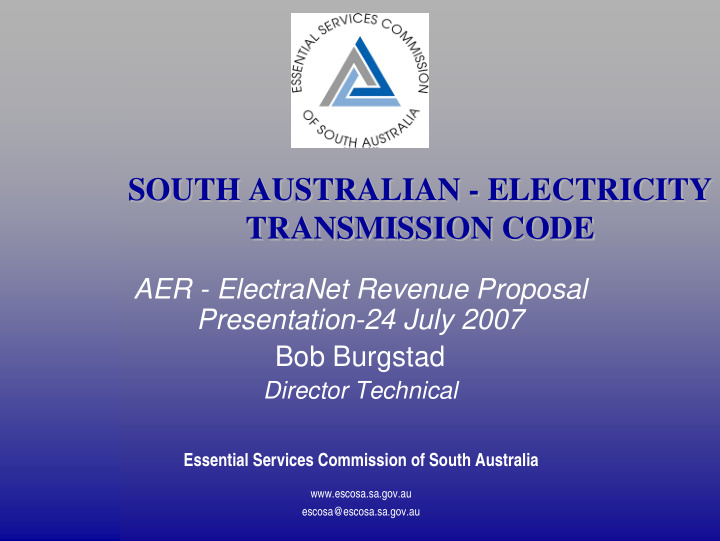



SOUTH AUSTRALIAN - ELECTRICITY SOUTH AUSTRALIAN - ELECTRICITY TRANSMISSION CODE TRANSMISSION CODE AER - ElectraNet Revenue Proposal Presentation-24 July 2007 Bob Burgstad Director Technical Essential Services Commission of South Australia www.escosa.sa.gov.au escosa@escosa.sa.gov.au
PURPOSE OF PRESENTATION PURPOSE OF PRESENTATION • Purpose of the Electricity Transmission Code (ETC)- particularly w.r.t exit point reliability; • Discuss the recent review of the ETC; • The review methodology; • Discuss the key recommendations;
The Electricity Transmission Code The Electricity Transmission Code • Established by SA Govt as part of the “sale” process; • Key focus of the Code are the service standards: � Quality of supply; � Reliability standards.
The SA Approach The SA Approach • SA approach is deterministic (but flexible) & determined by the jurisdictional Regulator; • It is different to the Victorian and NSW approach and the responsible parties are also different e.g. the standards are developed by VENCorp in Vic and by the NSW Government in NSW.
Reliability Standards Reliability Standards • The current code has 5 reliability categories which are primarily related to historical reliability performance. • The amended code does not come into effect until 1 July 2008. That is, the next regulatory period.
Category 1 Category 1 • Has N reliability; • AMD must not exceed 100% installed line and TF capacity; • Best endeavours to restore supply within 2 days of a line fault; • Best endeavours to restore supply within 4 days of a TF fault;
Category 2 Category 2 • Applies to Port Lincoln only; • N–1 line capacity for 2/3 AMD; • N–1 TF capacity for 100% of AMD; • Best endeavours to restore the N–1 line capacity to minimise the duration of an interruption; • If AMD exceeds N-I then augment to meet the standard within 3 years, best endeavours within 12 months.
Categories 3 and 4 Categories 3 and 4 • AMD not to exceed 100% of installed line and TF capacity; • Provide N–1 TF and line capacity; • The only difference is that Cat 4 requires the N–1 TF and line capacity to be continuously available.
Category 5 Category 5 • Applies to the CBD; • Standard intends to define the Adelaide Central reliability as N –2; • Current code requirements based on the historical operation of the integrated network by ETSA and ElectraNet SA; • Responsibilities not very clear.
The purpose of the recent review The purpose of the recent review • Review the basis of connection point reliability; • Review appropriateness of the existing connection point standards; • Should the reliability standards at any connection points be changed?; • Determine the costs / benefits of any proposed changes.
The review methodology The review methodology • Review in accordance with the defined criteria was done by the ESIPC. • Study based on economic assessment of each connection point. The capital cost of moving to the next highest reliability category was compared to value of increased reliability.
The review methodology The review methodology specifics specifics • Line outage rates and typical TF failure rates were calculated; • Outage rates and connection point demand was used to calculate undelivered energy; • Value of lost load was then calculated. This was based on $20,000 per MWh; • Connection points with high values of lost load were examined in detail to see if any reliability improvements were cost effective.
Changes Changes • Category 1 � Amend to allow 20% of AMD to be supplied through non-network solutions. • Category 2 � Delete and replace with new category 3. Proposed reliability standard of N+ allows for an interruption of 1 hour; � 20% of AMD can be provided by non-network solutions.
Changes – Continued Changes – Continued • New category 2 � N line capacity and N-1 TF capacity; � 20% of AMD can be supplied by non-network solutions. • Categories 3 and 4 � Consolidated in one category; � Reliability standard to be N-1 continuous.
Changes Continued Changes Continued • Category 5 � N-2 line reliability under normal conditions; � Allow 1 hour to restore supply if there are 2 concurrent line failures during a peak load period; � Peak load period defined as 90+% of AMD; � N-2 TF reliability standard.
Changes Continued Changes Continued • Category 6 � Covers Adelaide Central only; � Until Dec 2011 ElectraNet to provide line &T/F capacity equivalent to 100% AMD; � After 31 Dec 2011 ElectraNet to provide N-1 line & T/F capacity via independent and diverse substations; � Some specific restoration requirements.
General Changes General Changes • Redefine the Adelaide Central area; • ETSA to prepare 10 year peak load forecast for the CBD annually; • ElectraNet to undertake planning approval and easement acquisition prior to AMD breaching the reliability standards; • Non-network network support options should have minimum reliability/availability target of 95%; • ElectraNet to report on the above annually.
General Changes General Changes Continued Continued • ElectraNet to review TF failure rates and delivery times to ensure that spare TFs are available when required; • ElectraNet to demonstrate that its TF spares policy meets the reliability criteria; • TF definitions to include all associated equipment necessary to enable the TF to be connected to the network.
Questions Questions and / or and / or Comments ? Comments ?
Recommend
More recommend